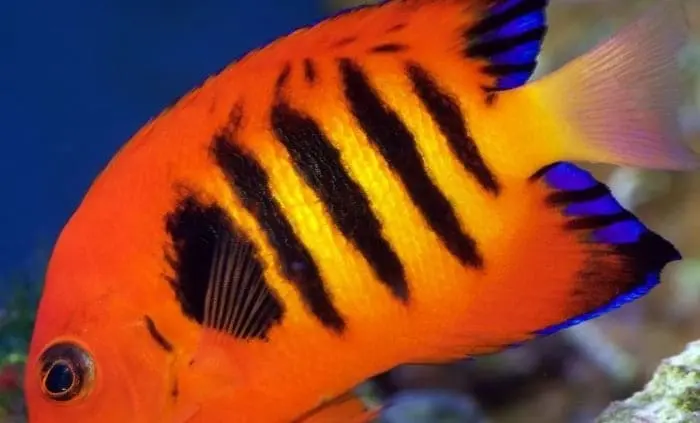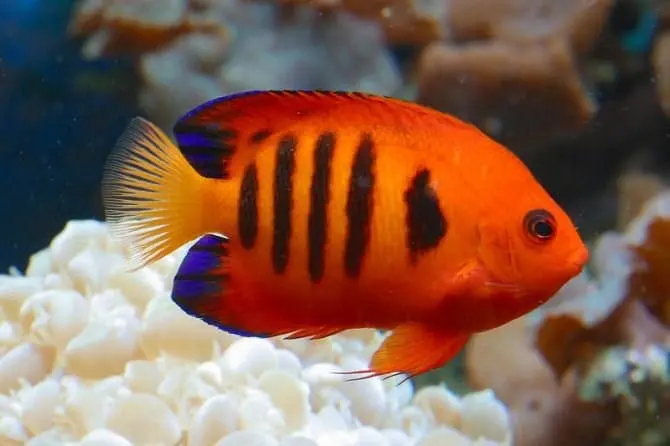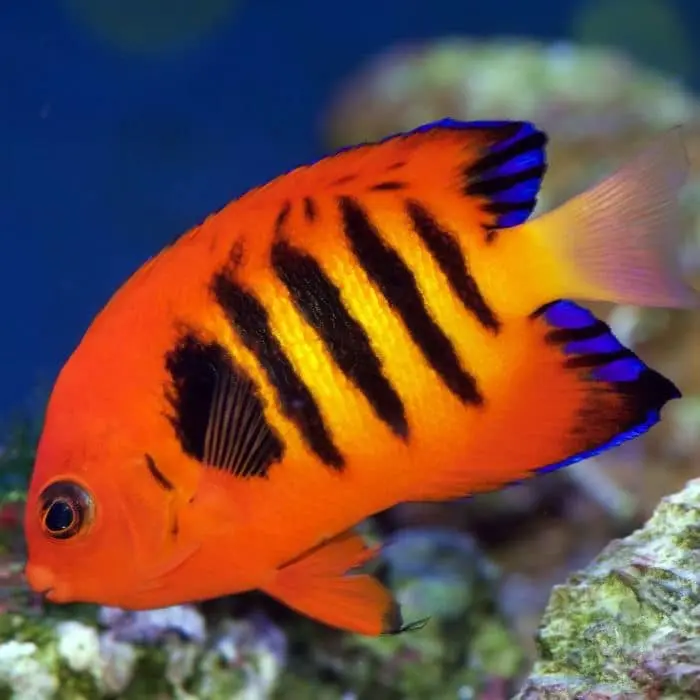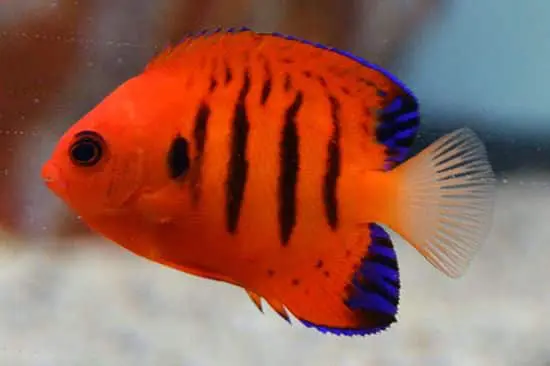
The Flame Angelfish (Centropyge loricula): A Bright, Lively Jewel for Your Marine Aquarium
The Flame Angelfish is a pint-sized showstopper that lights up any saltwater display. With glowing orange-red bars, inky edging on the dorsal and anal fins, and a bold, curious personality, the “Flame” is the kind of fish that turns everyday feedings into a mini celebration. This keeper-friendly guide covers care, diet, temperament, reef compatibility, and acclimation—plus quick spotlights on other popular species of angelfish for sale you’ll often see from quality marine retailers.
Ready to shop a curated lineup of beautiful angels? Browse Salt Water Fish Shop’s category of
angelfish for sale
and find the perfect size and personality for your tank.

Why Hobbyists Love the Flame Angel

Flames bring instant joy. They’re small enough for many modern displays, active without being frantic, and expressive—many will curiously inspect aquascape nooks and greet you at the glass. Under reef lighting, their reds and oranges pop with neon intensity, making them a natural focal point that still plays nicely with community fish when introduced thoughtfully.
- Size: Typically 3–4 inches as adults—compact, yet visually commanding.
- Temperament: Generally peaceful to semi-assertive; best kept singly unless your system is very large.
- Activity: Constant, confident gliding through archways and rockwork “alleys.”
Tank Size, Aquascape & Water Movement

While flames are considered “dwarf” angelfish, they appreciate room to roam. Prioritize tank length and open lanes over height. An aquascape with islands and arches lets your angel weave through the rock, establish safe hideouts, and display natural grazing behavior.
They enjoy moderate, oxygen-rich flow—enough current to keep them gliding comfortably and to suspend detritus for export, but not so chaotic that they have to fight the water. Surface agitation and skimming support strong gas exchange and bright behavior.
Diet & Color: Feeding for Vibrance
Flame angels are omnivores that do best on a varied, frequent feeding routine. Rotate high-quality marine pellets, enriched frozen blends, and offer nori several times a week. Many keepers also add sponge-based foods that mirror wild foraging. Small, consistent meals (2–3x daily) keep metabolism steady, support immunity, and help deter mischief like opportunistic nips at corals.
- Quality pellets formulated for marine omnivores.
- Frozen blends with marine proteins and algae content.
- Nori (seaweed) on a clip for grazing behavior.
- Occasional vitamin/amino enrichments to support color and appetite.
Reef Compatibility & Tankmates
Many aquarists keep flame angels successfully in mixed reefs, especially in mature, well-fed systems. Individual temperament varies—some specimens ignore corals entirely; others may sample fleshy LPS, clams, or polyps, particularly if underfed or stressed. The keys are steady nutrition, stable parameters, and a watchful eye during the first few weeks.
For tankmates, flames usually get along with peaceful community fish—clownfish, wrasses, gobies, blennies, basslets, and chromis. Avoid pairing with similarly shaped angelfish in smaller tanks, and introduce the flame after more timid species have settled. If keeping multiple dwarfs, you’ll need a very large system with plenty of rockwork and visual breaks.
Acclimation & First-Week Success
Successful introductions start with calm, predictable steps:
- Dim the lights for arrival day; reduce visual stress.
- Temperature equalize and drip acclimate to match salinity and pH.
- Offer a small meal (pellets or a tasty frozen blend) within an hour to build confidence.
- Observe swimming posture and breathing; a relaxed glide and energetic curiosity are green flags.
- Feed small portions 2–3x daily for the first week to reinforce calm, exploratory behavior.
Common Mistakes (and Easy Fixes)
- Underfeeding variety: A narrow diet can dull color and spark coral curiosity. Rotate foods.
- Low oxygen: Improve surface agitation and skimming for perkier, more resilient angels.
- Rushed introductions: Rearrange a bit of rockwork to “reset” territories before the angel’s first swim.
- Ignoring micro-territories: Provide multiple arches and hideaways so your flame can establish a cozy corner.
Other Popular Species of Angelfish for Sale
Flames are fantastic, but you’ve got lots of stunning options. Here are crowd favorites you’ll often find at a quality saltwater fish store. Use these links to explore current availability and plan your dream stock list.
Tip: If you’re building a wish list, mix body shapes and genera for harmony, and plan to introduce the most assertive species last.
Where to Buy (Happy Unboxings Start with Great Prep)
Choose a retailer known for careful conditioning, clear communication, and insulated, temperature-controlled shipping. For a polished experience—from browsing to splash-in—Salt Water Fish Shop makes it easy to pick confidently and enjoy your new centerpiece right away. TFlame Angelfish (Centropyge loricula): A Fiery Jewel for Happy Reefers
Ready to meet your next centerpiece? Browse beautifully conditioned
angelfish for sale
and find a perfect match for your tank and goals.
Why the Flame Angel Makes Hobbyists Smile
Flames are lively, compact, and striking—ideal for modern reef tanks that favor color and movement over sheer size. They learn your routine, glide through arches like ribbon dancers, and often greet you at the glass when it’s mealtime. Under reef lighting, their reds and oranges glow with neon intensity, creating a joyful focal point without overwhelming your scape.
- Adult size: ~3–4 inches; small fish, big presence.
- Temperament: Peaceful to semi-assertive; typically best singly unless your system is very large and well-structured.
- Activity: Confident cruisers—expect constant, curious exploration.
Tank Size, Aquascape, and Flow
Even though the flame is a dwarf angel, it appreciates room to roam. Prioritize tank length and open “lanes” over height so your fish can glide without stop-and-go traffic. Rock islands and archways create sight breaks and micro-territories; your angel will use them for quick retreats and playful loops.
Flow: Aim for moderate, oxygen-rich current. Surface agitation and skimming keep gas exchange strong (happy gills = happy angel). Avoid chaotic blasts that force constant effort; the flame should surf the current, not fight it.
Parameters & Stability
Angels love consistency. Keep salinity steady, maintain clean filtration, and avoid dramatic swings in temperature or pH. Mature rock with ample nooks supports natural grazing and confidence. A calm, predictable environment is the secret to an elegant, relaxed glide.
Feeding for Color and Confidence
Flame angels are omnivores that thrive on varied, frequent feedings. A simple weekly rhythm works wonders:
- Daily nori on a clip to encourage grazing behavior.
- Rotate quality marine pellets sized for smaller mouths.
- Add enriched frozen blends with marine proteins and algae content.
- Offer occasional sponge-inclusive foods (especially helpful for larger angels; still a nice treat for dwarfs).
- Use vitamin/amino soaks a few times per week to support color and appetite.
Small portions 2–3× daily keep metabolism steady, enhance color, and help deter coral sampling in mixed reefs.
Reef Compatibility (Real-World, Happy-Tank Tips)
Many keepers successfully house flame angels in mixed reefs—especially mature, well-fed systems. Individual personality varies: some flames ignore corals entirely, while others may investigate fleshy LPS, clam mantles, or polyps if underfed or stressed. Feed well, keep parameters stable, and observe. If you notice curiosity turning into snacking, adjust nutrition, add graze surfaces, or tweak aquascape flow to redirect attention.
Tankmates: Clownfish, wrasses, gobies, blennies, basslets, and chromis are great companions. Avoid stacking multiple dwarf angels in smaller tanks unless you have significant space and lots of line-of-sight breaks. Add the flame after timid species have settled, and introduce any more assertive fish last.
Acclimation & First-Week Success
- Lights low: Dim or ramp down lights during arrival to reduce stress.
- Match & drip: Float to equalize temperature, then drip acclimate to your salinity/pH.
- First snack: Offer a small, enticing meal within an hour to build confidence.
- Observe posture: A relaxed glide and curious stops at rockwork are green flags.
- Small, frequent feeds: 2–3× daily for the first week helps cement calm behavior.
Health & Long-Term Happiness
Healthy flames have bright eyes, lively fins, steady breathing, and confident cruising. Support immunity with stable water, oxygenation, and diet variety. Quarantine when you can, and keep a gentle observation routine—ten calm minutes a day spotting subtle changes (appetite, color, posture) will make you an angelfish whisperer in no time.
Other Popular Species of Angelfish for Sale
If the Flame Angel has sparked your interest, you’ll love exploring these favorites too. Each brings its own color palette, shape, and personality—perfect for planning future upgrades or a showpiece FOWLR.
- Queen Angelfish — Electric blues and golds; a radiant centerpiece for large systems.
- Annularis Angelfish — Striking ringed juvenile pattern that shifts with age.
- French Angelfish — Bold scales and stately presence; a classic Caribbean icon.
- Passer (King) Angelfish — Personality plus; best with confident tankmates and space.
- Majestic (Blue-Girdled) Angelfish — Sophisticated patterning for calm, mature displays.
- Blueface Angelfish — Masked elegance with canary and cobalt highlights.
- Pygmy (Dwarf) Angelfish — A diverse group including Coral Beauty, Lemonpeel, and more.
- Emperor Angelfish — Famous juvenile rings; regal adult livery in stable, large aquariums.
- Koran (Semicirculatus) Angelfish — Another ringed juvenile that transforms dramatically.
- Singapore Angelfish — Subtle beauty that rewards patient aquarists.
- Multicolor Angelfish — Pastel charm in a compact, reef-aware package.
Species Links — Saltwater Fish Store
Use these quick links to browse current availability and care notes. Build your wish list, compare sizes, and plan stocking harmony with confidence:
Species of Angelfish for sale at Saltwater fish store.
- Annularis Angelfish
- Flame Angel
- Passer Angelfish
- Majestic Angelfish
- Blueface Angelfish
- pygmy angelfish
- Emperor Angelfish
- Koran Angelfish
- Singapore Angelfish
- Multicolor Angelfish
Pro tip: When mixing angels, choose different body shapes/genera, add simultaneously, and provide multiple rock “zones.” Add the most assertive fish last.
Where to Buy (Happy Unboxings Start with Great Prep)
Choose a retailer that conditions fish carefully, ships in insulated, temperature-controlled packaging, and supports you with friendly guidance. For a polished experience from browsing to splash-in, explore Salt Water Fish Shop’s curated category of angelfish for sale. Compare sizes and temperament at a glance, pick the personality you love, and look forward to that magical first glide across your aquascape.
